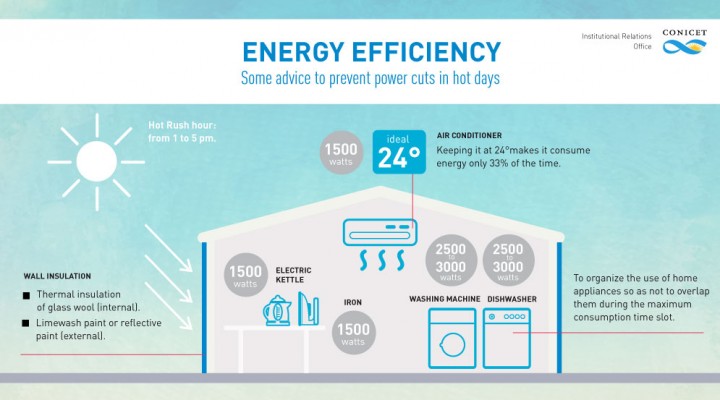The best solution: thermal insulation
CONICET scientist proposes improve the thermal quality of houses to curve power consumption and prevent power cuts.
Hot days increase the demand of electric power due to the rise in the number of air-conditioners working almost permanently. This situation makes that at times transformers that distribute power collapse and produce power cuts that extend until the necessary repairs are carried out, what can take several days.
Luis Eduardo Juanicó, CONICET independent researcher at the Centro Atómico Bariloche (CAB) de la Comisión Nacional de Energía Atómica (CNEA) [Bariloche Atomic Center of the National Commission of Atomic Energy], provides a long-term solution from the point of view of sustainability and rationalization of the power distribution system. For him, the best solution is to invest in the improvement of the thermal quality of the houses.
“Houses in Argentina are built without thermal insulation, so it is possible to say that we live in cement tents with air conditioner. For instance, a cement wall that faces the north, without insulation, on a hot day can reach 50 degrees and it is for this reason that when people set the air conditioner at 24 degrees is not enough. The problem is that although the temperature is set at 18 degrees, there will not be comfort because asides from the hot air than surrounds the environment, the wall produces heat through infrared radiation”, the researcher describes.
For Juanicó, to thermally insulate the houses will not only improve the quality of life of the population but it not as expensive when compared to the great investments demanded by the power distribution system and the global cost of the houses. “To put a 5 centimeters layer of thermal insulation made of fiberglass costs ARS$50 per square metre and it can lower the temperature of a wall up to 20 degrees. It would also be useful to paint the buildings with lime like in the old times or to use reflective paint. Contrary to that, most of modern paints absorb the heat”, the scientist states.
Furthermore, Juanicó considers that these modifications could contribute to cut the power consumption both in hot days as well as in winter heating. He also thinks that to invest only in electric network without improving the thermal quality of the houses at the same time would not provide a solution to the problem. “We want to solve everything by oversizing the electric network, which is a very bad idea. As long as we do not find a way to insulate the houses thermally, the demand for electricity will increase and the problems will remain”, he states.
“Compared to the average market price of a new flat, by increasing the investment less than one per cent, it would be possible to improve significantly the thermal quality used to build. With this amelioration, the electric system will globally benefit not only the distribution network –what would enhance the reliability provided to users- but also the generating facilities, because it will reduce the time the less efficient power stations – the ones that are used to meet the demand during rush hours – are on. I think that the real change will begin when we all become aware of the fact that we can build a more sustainable city”, Juanicó affirms.
Postponing consumption without privations
The researcher states that power cuts would not be produced by the increase in the global consumption of power but rather by its concentration in certain temporary segments. For this reason, he recommends moving the use of household appliances that consume high electric power – considering power as the intensity of energy, measured in watts- and are not linked to refrigeration needs, to outside the maximum consumption time slot. In hot days, that time slot is from one to five in the afternoon, the moment in which the air conditioners of the offices are in full swing.
“I am not suggesting that people should save energy at home because that would involve privations. Instead of that, I recommend that users should postpone or advance the consumption of some domestic appliances within the time of one same day. During the time slots when energy consumption rises because all air conditioners are on, we should try to avoid the use of the washing machine, dishwasher, iron or electric kettles. For instance, if someone needs to use the washing machine for three hours a day, this person can go on doing it but instead of using the machine between 1 and 5 pm, the recommendation is to do it early in the morning or at night, after 10 PM”, the scientist explains.
“The problem is not the nationwide electricity supply; it has to do with its distribution. When transformers cannot distribute all the energy demanded during a certain period, they may fail or burn the high voltage cables. This means that the problem is in the production of electric power and not in the quantity of energy in absolute terms”, he adds.
As regards the specific use of air conditioners, Juanicó, far from advising against its use, suggests keeping them at 24 degrees so as to make them consume average energy only 33 per cent of the time. “The transformer of a building that has one hundred flats with all air conditioners on at 24 degrees, takes an average equivalent to 33 appliances constantly on; however, if they were at 18 degrees, that amount would triple”, the researcher exemplifies.
By Miguel Faigón.
English version: Cintia B. González
